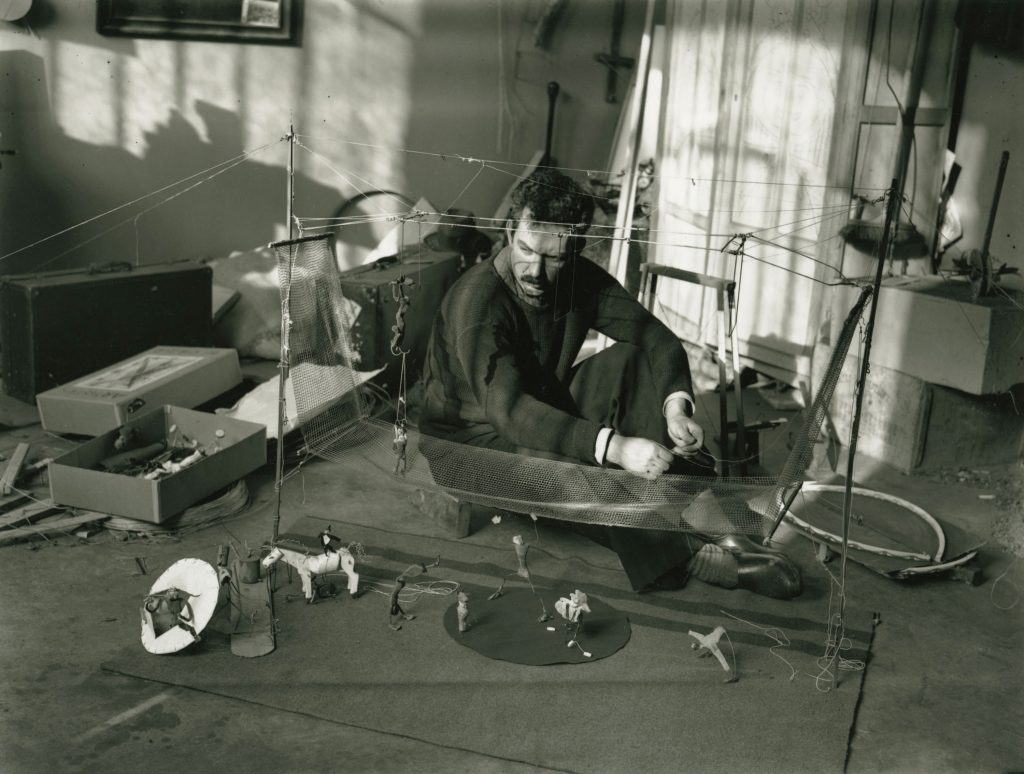
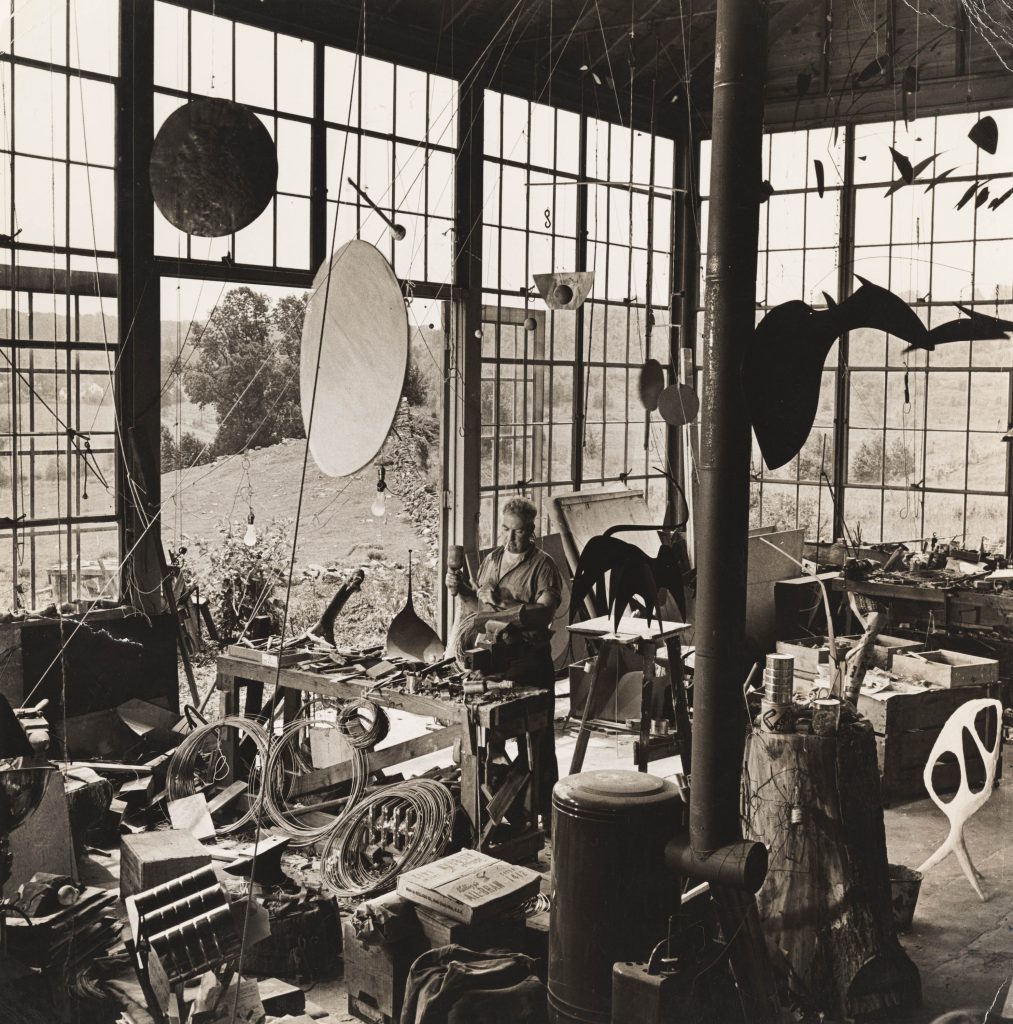
Noise is another whole dimension.
Alexander Calder[1]
A mobile carves its habitat. Alternately seductive, stealthy, ostentatious, it dilates and retracts, eternally redefining space. A noise-mobile produces harmonic wakes—metallic collisions punctuating visual rhythms.[2] For Alexander Calder, silence is not merely the absence of sound—silence generates anticipation, a bedrock feature of musical experience. The cessation of sound suggests the outline of a melody.[3]
A new narrative of Calder’s relationship to sound is essential to a rigorous portrayal and a greater comprehension of his genius. In the scope of Calder’s immense œuvre (thousands of sculptures, more than 22,000 documented works in all media), I have identified nearly four dozen intentionally sound-producing mobiles.[4] Calder’s first employment of sound can be traced to the late 1920s with Cirque Calder (1926–31), an event rife with extemporised noises, bells, harmonicas and cymbals.[5] His incorporation of gongs into his sculpture followed, beginning in the early 1930s and continuing through the mid-1970s. Nowadays preservation and monetary value mandate that exhibitions of Calder’s work be in static, controlled environments. Without a historical imagination, it is easy to disregard the sound component as a mere appendage to the striking visual mien of mobiles. As an additional obstacle, our contemporary consciousness is clogged with bric-a-brac associations, such as wind chimes and baby crib bibelots.
As if sequestered from this trail of mainstream bastardisations, the element of sound in certain works remains ulterior. At first glance, the musical dimension of Untitled (c. 1934) is uncertain. The mobile, repurposed pieces of pipe and a wooden ball, is too big to fit inside its iron hoop. Set in motion, it strikes the hoop—Dwong!—and stolidly adjusts itself with knocks and pings.


The fickleness of the collisions is frustrating—they come when one least expects them to, or not at all, generating another kind of noise: the internal babble of our (re)adjustments. Untitled (1936) contains a vertical wire threaded through its squashed coronet, trailing down to a white wooden ball that dangles suspiciously in the immediate neighbourhood of the black base, ready to bump against, kiss or whack it.13 Spines (1940) also produces noise en passant. One can picture Calder in his studio gathering the rods of this mobile together in his hand and then releasing his grip, provoking the chine-like cascade to collide jangling.
He worked without assistants and in complete silence, apart from the frequent sounds of clanging metal brought about by gusts of air; the many sculptures adrift in the rafters of his studio created an anarchic foliage. Like a clock wiped clean of its face, The Gong (c. 1933) loomed overhead from Calder’s procurement of his Roxbury studio in 1938 until his death in 1976. Jean-Paul Sartre describes his encounter with the anthropomorphic work: “I once saw a beater and gong hanging very high up in his studio. At the slightest draught of air, the beater went after the rotating gong. It would draw back to strike, lash out at the gong and then, like a clumsy hand, miss. And just when you were least expecting it, it would come straight at it and strike it in the middle with a terrible noise.”[6] André Masson depicts The Gong’s totemic quality in his poem “The Studio of Alexander Calder”:
Hung from the studio’s rafters,
in the streaks of light a gong sensitive to the caprices
of air is struck only with the greatest caution
With the step of a dove it rings: what hour does it sound?
This is the hour of bustling centipedes
It is also the hour of the child with cherries.
Here the seconds lack the weight of the clock
they do not rest in the grass
they cannot conceive of immobility
they love the rustling of reeds
and the cry of the tree frog who breathes music
they play between your fingers, Calder, my friend.[7]
Masson’s poem reveals the dimension of time peculiar to noise-mobile compositions, integrative constructions made possible by the spectator’s projection of linear time; patterns of sound/silence create compositions cobbled from memory snapshots, with beginnings and endings given arbitrary placements.[8]
Calder’s incorporation of sound indicates his receptivity to accidental phenomena in his working environment. More specifically, his employment of percussion is an extension of a desire to increase levels of variation and synergise disparate ingredients. Indeed, the mercurial constitution of sound itself presents a boundless range of variance. “To me the most important thing in a composition is disparity,” Calder wrote in 1943. “Anything suggestive of symmetry is decidedly undesirable, except possibly where an approximation of symmetry is used in a detail to enhance the inequality with the general scheme.”[9] Calder favoured the term “disparity” to describe his practice: “The idea of one body moving about another body which is doing something else, all by itself, is very exciting to me. And I think I have remained faithful to this original conception—that disparity is the spice of life, i.e. disparity of form, size, density, color and motion and perhaps a few other things.”[10]
Among these “other things” was noise: Question: “How did you begin to use sound in your work?” Calder: “It was accidental at first. Then I made a sculpture called Dogwood with three heavy plates that gave off quite a clangor. Here was just another variation. You see, you have weight, form, size, color, motion and then you have noise.”[11]
In 1926, Calder wrote to his parents, “I have been going to see some concerts … I heard some Berlioz, + some Wagner, which are the principel [sic] things that rest in my mind.”[12] Mentioning two Romantic revolutionaries together—composers who moved beyond fixed classical forms and into a music of moods and atmospheres—shows Calder’s predilection for a modernist aesthetic.[13] It also forecasts his epochal visit to Piet Mondrian’s Paris studio in October of 1930. Already familiar with Mondrian’s geometric abstractions, it was the studio environment that shocked Calder fully into making abstract art. As he explained in his autobiography: “It was a very exciting room. Light came in from the left and from the right, and on the solid wall between the windows there were experimental stunts with colored rectangles tacked on … I suggested to Mondrian that perhaps it would be fun to make these rectangles oscillate.”[14]
For several weeks following the visit, Calder created a small series of non-objective oil paintings before ultimately settling on sculpture as his preferred medium. Since the mid-1920s, the artist had defined mass with shapes cut from air, “drawing” with wire to capture energy and motion. He retained this innovative approach in his new methodology: “When I use two circles of wire intersecting at right angles, this to me is a sphere—and when I use two or more sheets of metal cut into shapes and mounted at angles to each other, I feel that there is a solid form, perhaps concave, perhaps convex, filling in the dihedral angles between them. I do not have a definite idea of what this would be like, I merely sense it and occupy myself with the shapes one actually sees.”[15]
During the same period of the visit to Mondrian’s studio, Calder was introduced to the plus ultra-modern composer Edgard Varèse. Fourteen years Calder’s senior, Varèse crafted visceral sound-structures with unorthodox compositional material. When the pair first met, Varèse was in the thick of composing Ionisation (1929–31), the first standalone concert hall piece for percussion with no folkloric basis, the score of which demands an exotic array of noisemakers even by today’s standards. Varèse visited Calder in his studio in the months preceding Volumes–Vecteurs–Densités; Dessins–Portraits, his exhibition at Galerie Percier in April of 1931. In March of that year, Calder’s wife Louisa wrote to her mother-in-law, “Sandy is working downstairs, and talking to Varèse, the composer, whose music corresponds to Sandy’s wire abstractions, so he likes to watch him work.”[16] Testament to a burgeoning friendship, Calder executed a commanding wire portrait of the composer and a stabile, Musique de Varèse (c. 1931), an implied wire sphere containing an ebony cube and a minute, nether wooden sphere poised above a jagged airstrip of tin plated steel. “Crystallization” was among Varèse’s favourite words to describe the unfolding of his music; Musique de Varèse, perhaps Calder’s first light-reflecting sculpture, suggests penetration through a globe of pellucid substance, with droll objects disparately accenting the potentially blinding effect.[17]
Around 1932, Calder made an abstract ballet that consisted of “a frame with rings in the 2 top corners through which strings passed from the hands to the objects—springs, discs, a weight with a little pennant.”[18] A photograph from his studio during this period displays the musical component of the ballet, a collection of tin cans festooned from a string, organised roughly by size: “This was the ‘music’—Varèse liked ballet (but not ‘music’). I called it ‘A Merry Can Ballet.’”[19] Like Varèse (to say nothing of their mutual friend Marcel Duchamp), Calder was an insatiable punster. A Merry Can Ballet (phonetically, the French pronunciation of “American ballet”) may have been a sly nod to Varèse’s Amériques (1918–21, revised 1927), and conceivably a self-deprecating innuendo in response to Varèse’s candid dislike of jazz. Presumably improvisational in character, the music of the ballet starkly contrasts with Varèse’s credo of “organized sound” and anticipates the influence of the mobile on postwar music.
The vernacular of one artist resonates with that of the other to a remarkable degree. In his own practice, Calder employed “volumes, motion, spaces bounded by the great space, the universe.”[20] For Varèse, a kind of sculptural parlance mingles with his musical language. The composer was not being metaphorical when he said in 1936, “Taking the place of the old fixed linear counterpoint, you will find in my works the movement of masses, varying in radiance, and of different densities and volumes.”[21] In Varèse’s description of his composition Intègrales (1924–25), he might have been describing a Calder abstraction, perhaps most aptly a painting-in-motion such as Snake and the Cross (1936), which spotlights liquid evolutions of negative space circumscribed by its frame: “The changing projection of a geometrical figure onto a plane surface, with both geometrical figure and plane surface moving in space … each at its own changing and varying speeds of lateral movement and rotation.”[22]
“Why not plastic forms in motion?” Calder wrote in 1933. “Not a simple translatory or rotary motion but several motions of different types, speeds and amplitudes composing to make a resultant whole. Just as one can compose colors, or forms, so one can compose motions.”[23] That Calder could realise his sculpture all the way to its completion must have invigorated Varèse, who suffered much of his life from concepts too advanced for the existing technology, confining the composer to unconventional means with traditional orchestral instruments in order to approximate the desired effects.[24] Rather than blend tones into a harmonic fusion—a backward-looking practice of neo-Romanticists—Varèse extracted and combined pitch characteristics of timbre and overtones in an effort to make “discernible the different planes and various sound-masses, and so [create] the sensation of non-blending.”[25]
“When I was about twenty,” Varèse once reflected, “I came across a definition of music … as ‘the corporealization of the intelligence that is in sounds.’ It was a new and exciting conception and to me the first that started me thinking of music as spatial—as moving bodies of sound in space.”[26] Thus, sound is a type of raw material that must be organised and animated by an artist, in order to release its spirit. It was not until 1957 that Varèse entertained the idea of introducing improvisation into his music, when he took part in a series of “jams” with an all-star combo of jazz musicians organized by the composer Earle Brown in New York City. Still, imagining a sound-producing machine, Varèse remarked in 1962, “Whatever I write … it will reach the listener unadulterated by ‘interpretation.’”[27]
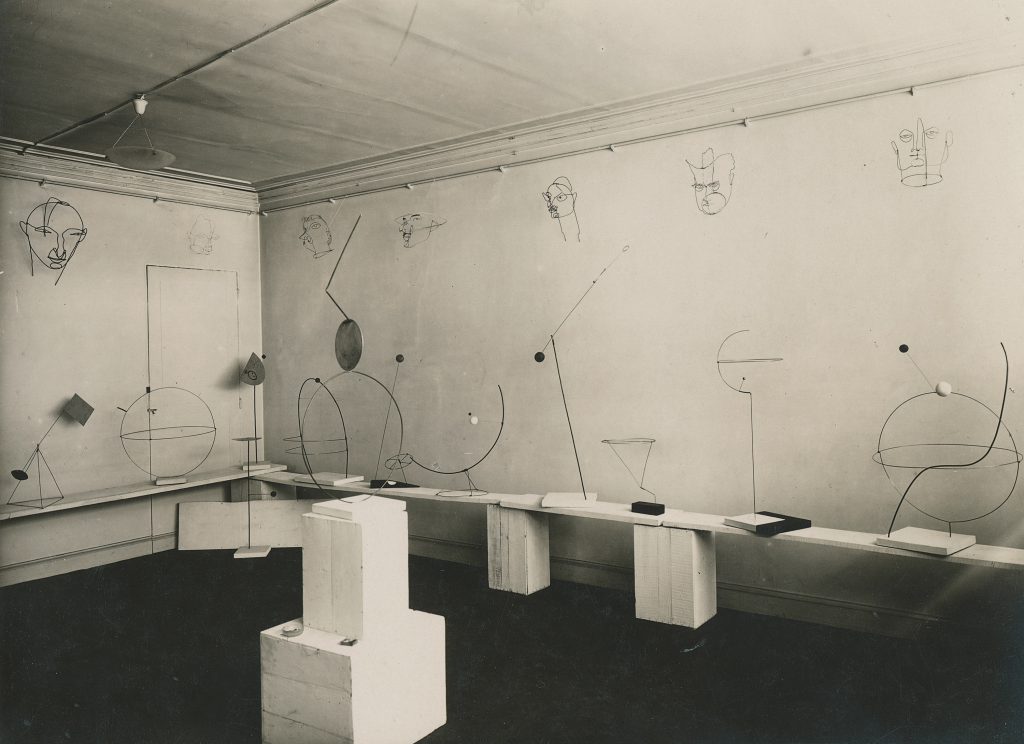
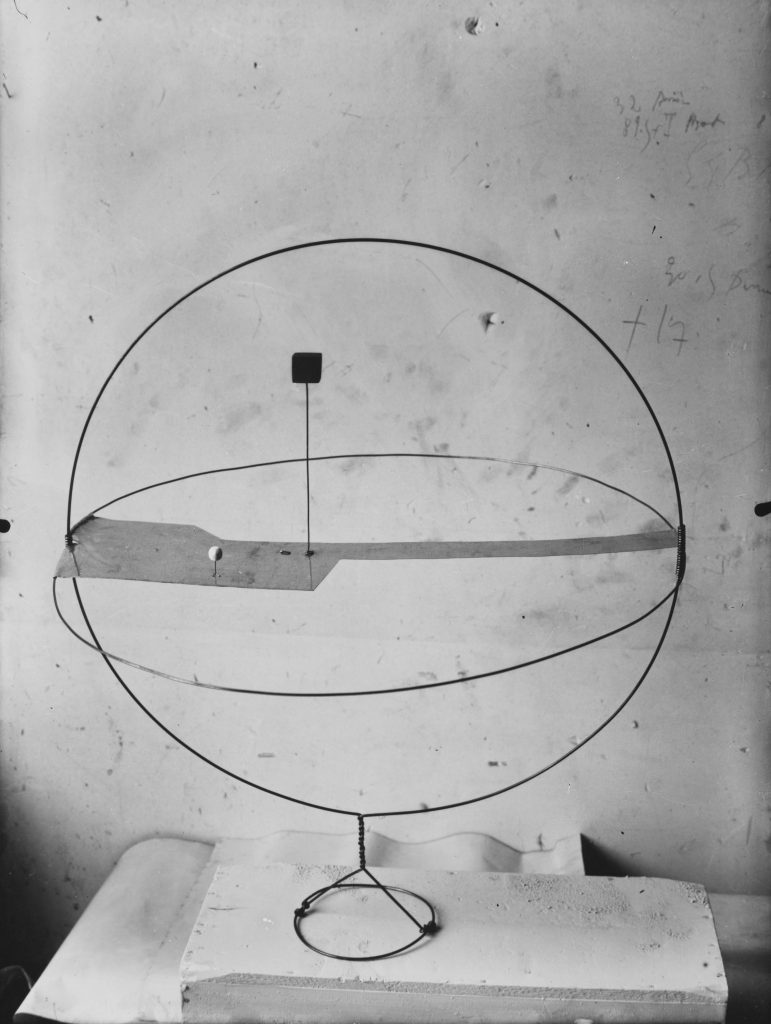
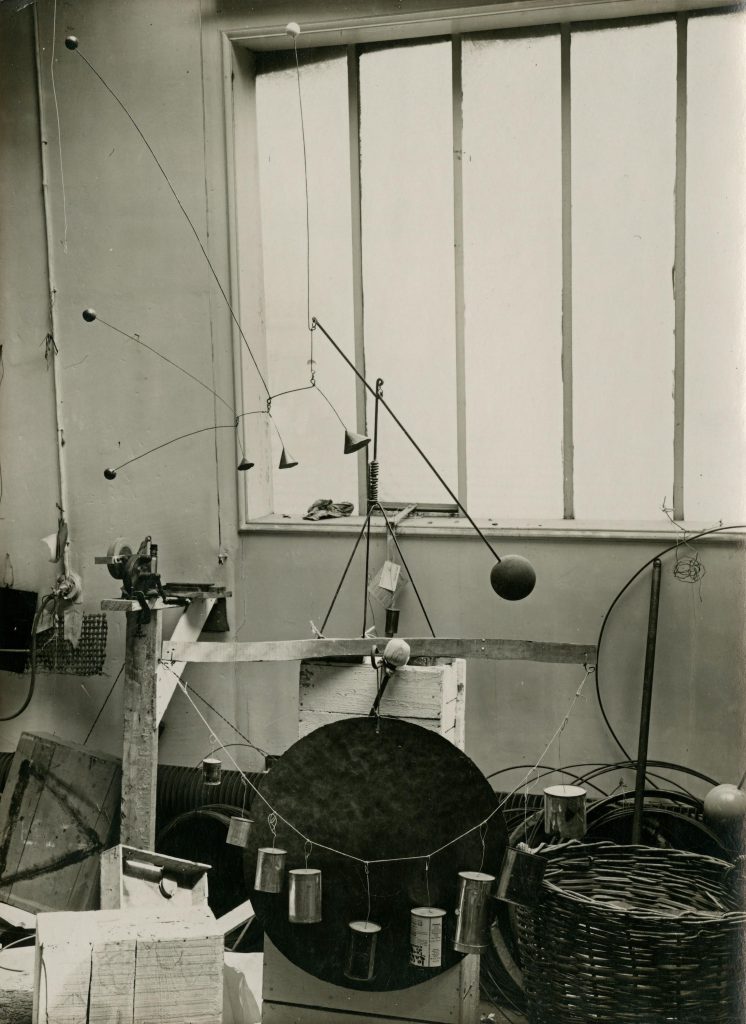
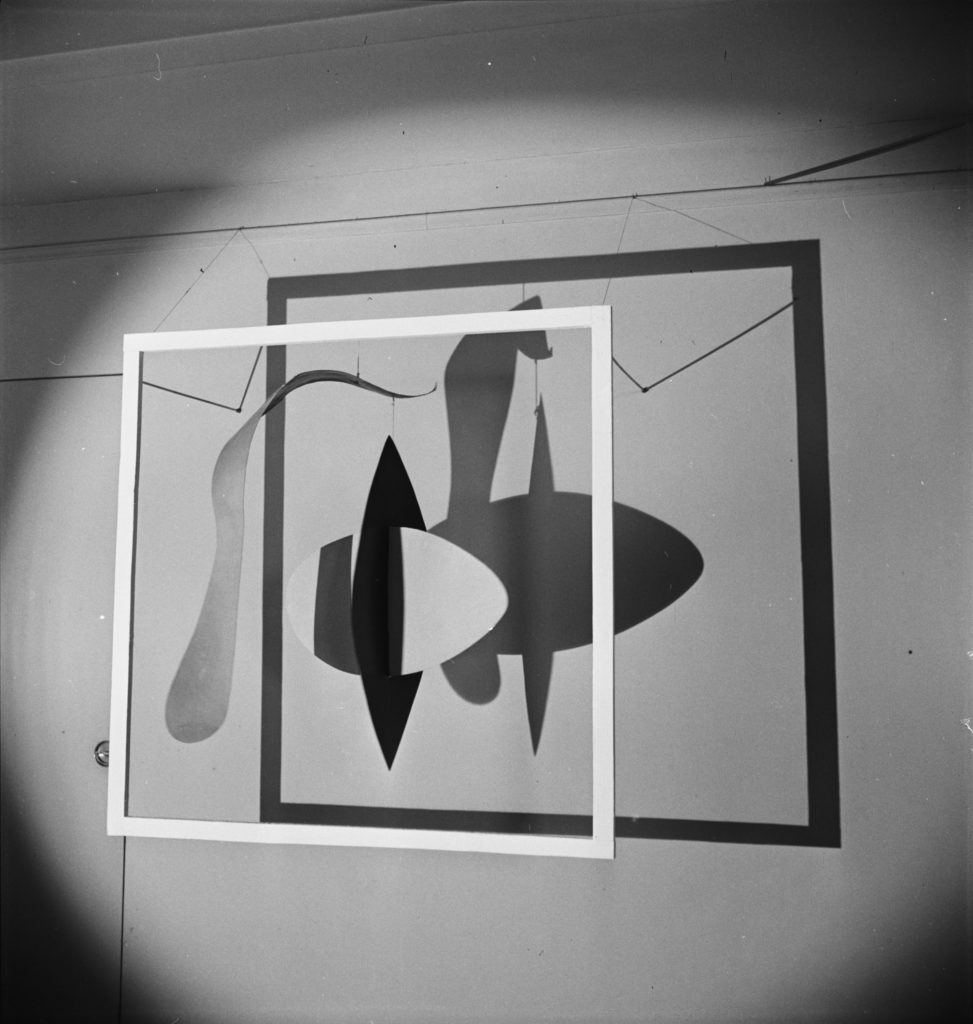
Calder’s application of sound in his invention of the first hanging mobile, Small Sphere and Heavy Sphere (1932/33), exposes his avant-garde roots.[28] Calder wrote to the curator James Johnson Sweeney in 1943: “One swings the red (iron) ball in a small circle—this movement + the inertia of the rod and the length of thread develop a very complicated pattern of movement. The impedimenta—boxes, cymbal, bottles, cans, etc. add to the complication, and also add sounds of thuds, crashes, etc.”[29] The spectator intervenes by (re)organising the configuration of impedimenta, made of recycled and repurposed quotidian objects, and nudging the red ball to initiate the mobile’s capricious course of collision. A real-time orchestration is generated, anticipating aleatoric and open form music of the post-World War II avant-garde.[30]
Calder determined impedimenta differentiated by pitch, timbre, and duration to produce a diversity of experiences. The ultimate visual and aural composition becomes a collusion of intervening forces—a collaboration between artist, spectator and climate. Parisian artists had employed laws of chance in Dadaist compositions before (for example, the collages of Jean Arp from 1916–17), but Small Sphere and Heavy Sphere is one of the first modern artworks featuring the radical intervention of the spectator. Preceding it was Calder’s creation of Object with Red Ball (1931), whose spheres and post can be recomposed, allowing the spectator’s subjective taste to determine a final aesthetic scheme.
Noise-mobiles are intended to make sound, and a spectator’s experience might feel incomplete when the work remains silent. In a drawing of Small Sphere and Heavy Sphere, Calder indicates that the bottles are empty; once struck they provide fuller, longer resonances. The sound of collisions between the elements lends a sense of palpability to the transfer of kinetic and potential energy.[31] Low volume resonances, sharp clinks, and hard bops serve as gratifying rewards and keep us hanging on. The work acts as a psychological experiment—our inner monologues flicker with anticipation: Will the ball connect? What sound will it make? When is the right moment to walk away?
Chance music is not for everyone. The lack of a trace of human intention risks leaving an audience cold, mystified, not “in” on the event. On the contrary, Small Sphere and Heavy Sphere elicits overt reactions. People laugh, gasp and discuss. The tangible suspense in the room recalls Gabrielle Buffet-Picabia’s description of a work at Calder’s 1932 Galerie Vignon exhibition: “A moving arabesque in wire balances itself and seems destined to interrupt the agitated path of a pendulum. Will they meet? No. They avoid one another with an infinitesimal precision.”[32]
For his retrospective in 1969 at the Fondation Maeght in Saint-Paul-de-Vence, France, Calder overhauled and transfigured Small Sphere and Heavy Sphere under a new title, Une Boule Noire, Une Boule Blanche (1969)—one of the few instances in which he revisited past works. In the experimental stage of the sculpture’s revitalisation, Calder auditioned a similar set of objects, including wooden boxes, metal discs, and bowls from his Roxbury kitchen. Ultimately, he did away with the bricolage and instead ordered nine steel gong-like bowls that varied greatly in size, although uniformly in Calder red, to be fabricated and “tuned” with the assistance of an ironworks in Tours, France. For “Calder’s Universe” in 1976 at the Whitney Museum in New York, throngs of people crowded the edges of the sculpture, attracted as they were in 1969 to “sounds of solemn bells.”[33]
From the late 1930s through the mid-1940s, Calder suspended sonorous elements in shared proximity, granting them freedom to pivot and resonate. The sundry clangours of Black Foliage, Red Branch (1945) represents this style, in contrast to Calder’s gongs with protruding strikers. Boomerangs (1941), the airborne cousin of The Clangor (Dogwood, 1941), is one of two sculptures for which he fashioned chain-linked wire attachments.[34] A critic reviewing Calder’s 1941 Pierre Matisse Gallery show singled out the sonic feature of The Clangor: “There is one mobile in particular … ‘weighted’ by metal disks of such tonnage that, colliding, they are metamorphosed into deep-throated bongs.”[35]
Calder was also interested in the visual effect of gongs. Two Silent Gongs (1974), the title of which speaks for itself, may have been repurposed from an earlier noise-mobile. Black Tulip (c. 1942), a spray of arching florets, features a gong that silently revolves, while small rings drooping from horizontal bars smack the black forms of its base. There are noise-mobiles of furtive, quieter stock, for example the tinkling pitchfork shards of Tines (1943), or the black moon on the verge of being tapped by the miniscule sphere at the heart of Tentacles (1947).
By the late 1940s, Calder had synthesised mobiles and gongs and showcased his formalisation in “Alexander Calder: Gongs and Towers” at the Curt Valentin Gallery in 1952.[36] Prototypical of this refined style is Triple Gong (c. 1948), with its red tendril-like wires plunging down through space and perking up to terminate in metal cylinders (beaters) in plane with three brass gongs hung in a sequence of pitches. Calder applied this technique, where mobiles breathe independently and yet in agreement with their gong supplements, throughout the 1950s and into the 1960s with Big Gong (1951); Red Gong (1951); Red, Yellow and Blue Gong (1951); Sumac with Gong (1951); two works known as Triple Gong (1951); Red Gongs (1951); Double Gong (1953); Horizontal Red Moon Gong (1957); and Blue Moon (1962).
A study of Calder’s musical influence is waiting to be written. One point of orientation begins in the late 1940s when artists in America and Europe began to re-engage with Dadaist ideas; when John Cage secured a foothold and drew alliance with the re-emerging Duchamp. Seeking references to authorise and elucidate their strange musical articulations, and non-cloistered expression homologous to their new compositions, Pierre Boulez, Earle Brown, Aldo Clementi, Roman Haubenstock-Ramati, Mauricio Kagel, György Ligeti, Witold Lutosławski, Henri Pousseur and others compared their work to mobiles. “Mobile,” “stabile,” and “mobility” were terms soon absorbed into musical vocabulary, having become familiar to composers through lectures and performances at the Darmstadt International Summer Courses for New Music in Germany beginning in the 1950s. These Calder-derived concepts grew into flexible descriptors for dynamic innovations to the musical score. “Mobiles,” as Polish composer Lutosławski described sections of his String Quartet (1964), are “passages of collective ad libitum in which the parts contain discrete repeated fragments…. The aural result is analogous to the visual effect when a mobile of Alexander Calder is viewed from different angles. The relation of part to part and part to whole is constantly changing, familiar fragments of sound returning in ever-new contexts.”[37]
Taking cues from Calder and literary modernists such as James Joyce, Stéphane Mallarmé and Gertrude Stein, composers radically re-evaluated not only the musical score but also its performative implications. Proponents of the new avant-garde identified the traditionalist presumption that musicians were empty vessels to be filled, mechanisms for realising “closed,” fixed scores. Traditional goals of a musical performance (for example, the precise interpretation of a composer’s intent, interspersed with displays of technical virtuosity) were set in contrast to “open” scores, which require active participation and decision-making by the performer. The degrees between these two performer roles (one leaving no room for interpretation, the other offering choice and collaboration) became a field of dispute and experimentation.[38]
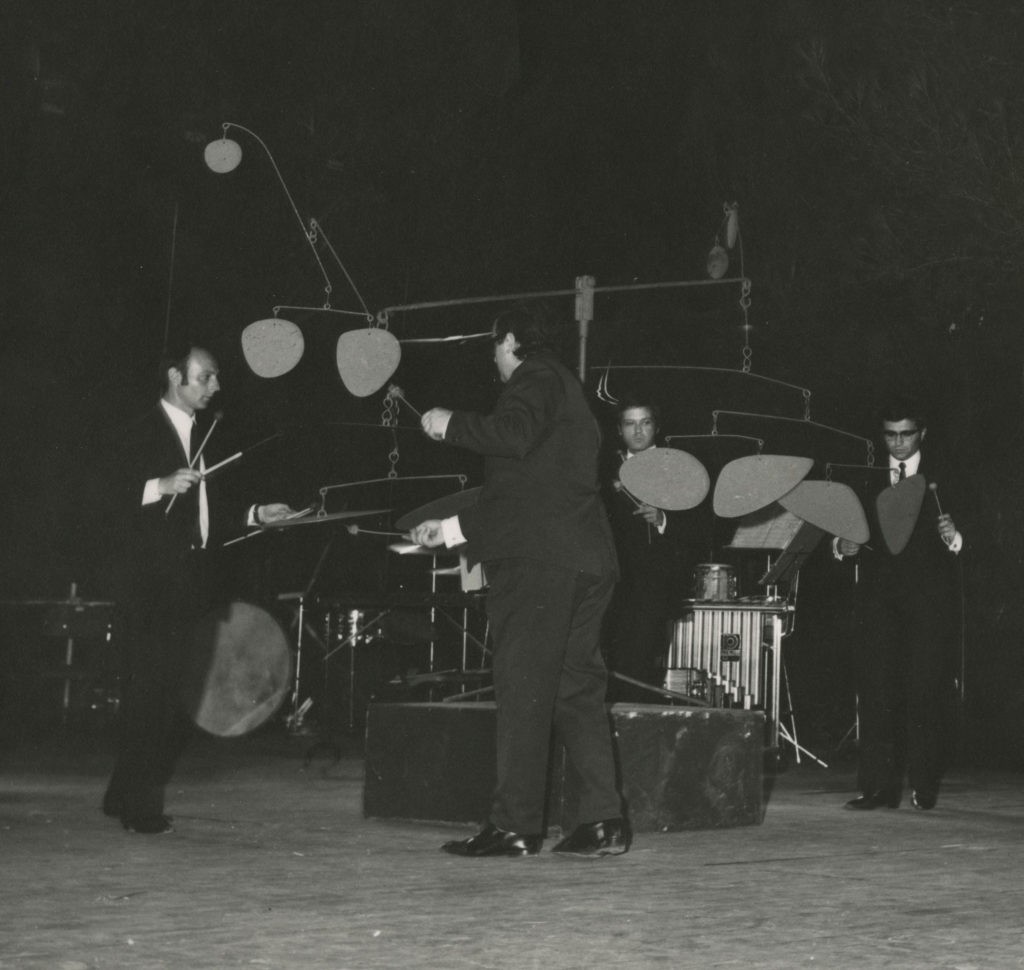
“Time is the actual dimension in which music exists when performed and is by nature an infinitely divisible continuum. No metric system or notation based on metrics is able to indicate all of the possible points in the continuum, yet sound may begin or end anywhere along this dimension.”[39]
Composer Earle Brown’s first encounter with a mobile in the late 1940s prompted his invention of “mobile composition,” a type of music later popularised in Europe as open form. A member of the New York School (along with Cage and Morton Feldman), Brown became obsessed with the mobile’s musical parallels and his landmark December 1952 (1952–54) suggests punctuated constellations of quick-witted improvisation. Resembling a visual artwork, the score is a grid of thirty-one randomly placed shapes, which Brown conceived as a freeze-frame of constantly evolving points of infinite direction. Performable “in any direction from any point in the defined space for any length of time” (and for any number of performers and types of instruments with no specification of rhythm), musicians must enter the score’s imaginary landscape and personally navigate its depths with musical decisions.[40]
In 1963, Brown received a commission from Diego Masson, the son of André Masson, to write a piece for his First Percussion Quartet of Paris. In a gesture of homage to his hero, Brown began work on a composition to be conducted by a mobile. He visited Calder in his studio in Saché, France, to propose the idea, and Calder was, by Brown’s account, immediately intrigued. To radicalise the concept further, the mobile also would be played as an instrument. Three years later, Calder’s monumental standing mobile Chef d’orchestre (1966) arrived in Paris. Brown had assigned cues for the percussionists corresponding to the mobile’s presumed colors. As it arrived painted entirely red, he hastily adapted his composition to the monochromatic scheme.
Chef d’orchestre has been described as a “bony, angular, multilimbed conductor.”[41] Its fourteen circular and ovoid elements, which hover within a drummer’s reach, provide different pitches, apart from two of the same. When struck with mallets the mobile produces round, short-decay gongs. Brown’s Calder Piece (1963–66) places four percussionists at corners equidistant to Chef d’orchestre and equipped with a battery of more than 100 percussion instruments. At several points, the percussionists advance upon the mobile, strike its bobbing forms, and leaving it swinging, sprint back to “read” its varying configurations.[42] In order to interpret its gestures, the percussionists imagine the mobile’s “petals” on the page, and play the phrases traced by the shape. The music develops from inarticulate noises of friction to solos and duos ranging from hesitant to obstreperous, with an earsplitting explosion toward the end. A feedback circuit develops as the perspectives of the musicians change in relation to the spinning conductor. The spectacle bespeaks the synaesthetic effect of Calder’s work: music through exquisite movement. The première performance at the Théâtre de l’Atelier in 1967 was met with much acclaim, with one critic remarking, “Such a phenomenon of resonant exchange between the musical and the plastic-visual elements will remain one of the most enriching conquests of our time.”[43]
Beyond his stature as a composer of motion, Calder expanded the vocabulary of sculpture by permitting his mysterious objects noise-making capabilities. An artist who addressed issues fundamental to composers of music, Calder was a visionary of the increasingly blurred, intermingling categories of art. At a time when contemporary sound art is receiving ever-increasing attention in galleries and museums, Calder stands as a foundational figure and a primary twentieth-century source for compositional experimentation.
Hauser & Wirth, Los Angeles. Calder: Nonspace. Exhibition catalogue. 2019.
Andrew Berardini, The Cosmic Mathematics of Alexander Calder
Solo Exhibition CatalogueAlmine Rech Gallery, New York. Calder and Picasso. Exhibition catalogue. 2016.
Robert Slifkin, The Mobile Line
Susan Braeuer Dam, Liberating Lines
Jordana Mendelson, Picasso, Miró, and Calder at the 1937 Spanish Pavilion in Paris
Group Exhibition Catalogue“Calder in France.” Cahiers d’Art, no. 1 (2015). Edited by Alexander S. C. Rower.
Susan Braeuer Dam, Calder in France
Robert Melvin Rubin, An Architecture of Making: Saché and Roxbury
Agnès Varda in conversation with Joan Simon
Magazine, MonographMuseo Jumex, Mexico City. Calder: Discipline of the Dance. Exhibition catalogue. 2015.
Alexander S. C. Rower, Calder: Discipline of the Dance
Solo Exhibition Catalogue